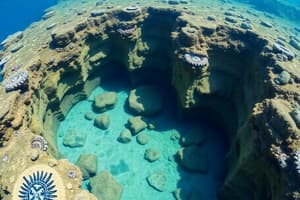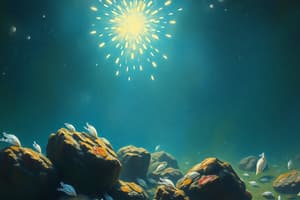Podcast
Questions and Answers
What are submarine ridges primarily associated with?
What are submarine ridges primarily associated with?
- Areas where continental crust is lost
- Tectonic plate separation (correct)
- Locations of ancient ocean floors
- Regions of high seismic activity
What is the lithosphere composed of?
What is the lithosphere composed of?
- Partly molten asthenosphere
- Liquid mantle material
- Cracked sections of the Earth's crust (correct)
- A thick layer of magma
What drives the movement of tectonic plates?
What drives the movement of tectonic plates?
- Gravitational forces from the Moon
- The cooling of the oceanic crust
- A complex flow of thermal energy in the mantle (correct)
- Variations in sea level
How does new crust form at ocean ridges?
How does new crust form at ocean ridges?
What occurs at ocean trenches?
What occurs at ocean trenches?
What marks the line of division at ocean ridges?
What marks the line of division at ocean ridges?
What is the estimated range of spreading rates of tectonic plates?
What is the estimated range of spreading rates of tectonic plates?
Which type of tectonic plate only carries ocean floor?
Which type of tectonic plate only carries ocean floor?
What primarily affects the composition of the seabed?
What primarily affects the composition of the seabed?
Which of the following factors influences the type of sediment found on the ocean floor?
Which of the following factors influences the type of sediment found on the ocean floor?
According to Stokes’s Law, what primarily determines the settling velocity of particles?
According to Stokes’s Law, what primarily determines the settling velocity of particles?
What is commonly found on the shallow water seabed due to tidal currents and waves?
What is commonly found on the shallow water seabed due to tidal currents and waves?
Which condition leads to finer sediments being more likely to remain suspended in the water column?
Which condition leads to finer sediments being more likely to remain suspended in the water column?
What happens to sediment transport when the speed of bottom current exceeds the settling velocity of particles?
What happens to sediment transport when the speed of bottom current exceeds the settling velocity of particles?
Where is rock commonly uncovered on the ocean floor?
Where is rock commonly uncovered on the ocean floor?
What is primarily true about the majority of the ocean floor's coverage?
What is primarily true about the majority of the ocean floor's coverage?
What material primarily composes diatom ooze?
What material primarily composes diatom ooze?
Where does radiolarian ooze predominantly occur?
Where does radiolarian ooze predominantly occur?
What is the primary composition of red clay found below 6000 m in the ocean?
What is the primary composition of red clay found below 6000 m in the ocean?
What characterizes the accumulation rate of red clay compared to organic oozes?
What characterizes the accumulation rate of red clay compared to organic oozes?
What defines the size of polymetallic nodules found on the ocean floor?
What defines the size of polymetallic nodules found on the ocean floor?
Which metal is not commonly found in polymetallic nodules?
Which metal is not commonly found in polymetallic nodules?
What process primarily contributes to the formation of red clay sediments in the ocean?
What process primarily contributes to the formation of red clay sediments in the ocean?
What depth range is mentioned as the area where polymetallic nodules are abundant?
What depth range is mentioned as the area where polymetallic nodules are abundant?
What recent discoveries have changed the perception of the seabed?
What recent discoveries have changed the perception of the seabed?
What is the significance of the Kaikoura Canyon?
What is the significance of the Kaikoura Canyon?
How deep is the Kaikoura Canyon?
How deep is the Kaikoura Canyon?
What major geographic feature divides the Atlantic Ocean?
What major geographic feature divides the Atlantic Ocean?
What unique characteristic is associated with canyons like Kaikoura?
What unique characteristic is associated with canyons like Kaikoura?
What is a significant biological feature of the Kaikoura Canyon?
What is a significant biological feature of the Kaikoura Canyon?
When were the major chains of mid-ocean ridges fully appreciated?
When were the major chains of mid-ocean ridges fully appreciated?
What feature defines the major chains known as mid-ocean ridges?
What feature defines the major chains known as mid-ocean ridges?
What regulates deep seabed mining outside individual country jurisdictions?
What regulates deep seabed mining outside individual country jurisdictions?
Which of the following conditions allows organic material to become buried and eventually form oil and gas deposits?
Which of the following conditions allows organic material to become buried and eventually form oil and gas deposits?
What are the potential long-term effects of mining nodules on marine populations?
What are the potential long-term effects of mining nodules on marine populations?
In which era were most oceanic oil and gas deposits formed?
In which era were most oceanic oil and gas deposits formed?
What is considered the most promising area for commercial extraction of polymetallic nodules?
What is considered the most promising area for commercial extraction of polymetallic nodules?
Which process leads to the formation of nodules from low-oxygen pore water?
Which process leads to the formation of nodules from low-oxygen pore water?
What is the primary organic matter that contributes to oil and gas deposits in the ocean?
What is the primary organic matter that contributes to oil and gas deposits in the ocean?
What is the typical average growth rate of polymetallic nodules over a million years?
What is the typical average growth rate of polymetallic nodules over a million years?
What materials can trap gas and oil beneath the surface?
What materials can trap gas and oil beneath the surface?
What material often serves as the nucleus for the formation of nodules?
What material often serves as the nucleus for the formation of nodules?
Which organisms are particularly associated with the nodule areas in deep-sea environments?
Which organisms are particularly associated with the nodule areas in deep-sea environments?
What is a common method used by scientists to collect seabed sediment samples?
What is a common method used by scientists to collect seabed sediment samples?
What dual factors contribute to the variation in the chemical composition of nodules?
What dual factors contribute to the variation in the chemical composition of nodules?
What type of spectroscopy can be used to analyze the detailed structure of nodules?
What type of spectroscopy can be used to analyze the detailed structure of nodules?
How long does it typically take for nodules to form?
How long does it typically take for nodules to form?
What role do colloidal particles play in the formation of nodules?
What role do colloidal particles play in the formation of nodules?
Flashcards
Tectonic plates
Tectonic plates
The rigid, moving pieces of Earth's lithosphere.
Ocean ridges
Ocean ridges
Vast systems of volcanic mountain chains that cross the ocean floor, marking the boundaries of tectonic plates.
Mid-ocean ridges
Mid-ocean ridges
Major mountain chains found in the Atlantic, Indian, and Pacific Oceans, running roughly north-south.
Ocean ridges
Ocean ridges
Signup and view all the flashcards
Ocean trenches
Ocean trenches
Signup and view all the flashcards
Mid-Atlantic Ridge
Mid-Atlantic Ridge
Signup and view all the flashcards
Seamounts
Seamounts
Signup and view all the flashcards
Sea-floor spreading
Sea-floor spreading
Signup and view all the flashcards
Submarine canyons
Submarine canyons
Signup and view all the flashcards
Lithosphere
Lithosphere
Signup and view all the flashcards
Kaikoura Canyon
Kaikoura Canyon
Signup and view all the flashcards
Asthenosphere
Asthenosphere
Signup and view all the flashcards
Tectonic plates
Tectonic plates
Signup and view all the flashcards
Rift valley
Rift valley
Signup and view all the flashcards
Tectonic plate movement
Tectonic plate movement
Signup and view all the flashcards
Bathymetry
Bathymetry
Signup and view all the flashcards
Seabed Composition
Seabed Composition
Signup and view all the flashcards
Soft Sediments
Soft Sediments
Signup and view all the flashcards
Strong Bottom Currents
Strong Bottom Currents
Signup and view all the flashcards
Sediment Type Variation
Sediment Type Variation
Signup and view all the flashcards
Sediment Settling Velocity
Sediment Settling Velocity
Signup and view all the flashcards
Stokes's Law
Stokes's Law
Signup and view all the flashcards
Ocean Sediment Age
Ocean Sediment Age
Signup and view all the flashcards
Continental Shelf
Continental Shelf
Signup and view all the flashcards
Diatom Ooze Composition
Diatom Ooze Composition
Signup and view all the flashcards
Diatom Ooze Location
Diatom Ooze Location
Signup and view all the flashcards
Radiolarian Ooze Composition
Radiolarian Ooze Composition
Signup and view all the flashcards
Red Clay Composition
Red Clay Composition
Signup and view all the flashcards
Red Clay Origin
Red Clay Origin
Signup and view all the flashcards
Deep-Sea Nodules Location
Deep-Sea Nodules Location
Signup and view all the flashcards
Nodule Composition
Nodule Composition
Signup and view all the flashcards
Nodule Distribution
Nodule Distribution
Signup and view all the flashcards
Deep Sea Mining
Deep Sea Mining
Signup and view all the flashcards
Polymetallic Nodules
Polymetallic Nodules
Signup and view all the flashcards
International Seabed Authority (ISA)
International Seabed Authority (ISA)
Signup and view all the flashcards
Epifauna
Epifauna
Signup and view all the flashcards
Anoxic Conditions
Anoxic Conditions
Signup and view all the flashcards
Organic Shale
Organic Shale
Signup and view all the flashcards
Oil and Gas Traps
Oil and Gas Traps
Signup and view all the flashcards
Sediment Sampling
Sediment Sampling
Signup and view all the flashcards
Hydrogenetic nodule formation
Hydrogenetic nodule formation
Signup and view all the flashcards
Diagenetic nodule formation
Diagenetic nodule formation
Signup and view all the flashcards
Nucleus of a nodule
Nucleus of a nodule
Signup and view all the flashcards
Patchy distribution of nodules
Patchy distribution of nodules
Signup and view all the flashcards
Growth rate of nodules
Growth rate of nodules
Signup and view all the flashcards
Economic potential of nodules
Economic potential of nodules
Signup and view all the flashcards
Clarion Clipperton Fracture Zone
Clarion Clipperton Fracture Zone
Signup and view all the flashcards
Study Notes
Chapter 1: The Physical Structure of Oceans
- This chapter describes the major physical features and zones of the ocean, essential for understanding marine communities and organisms.
- Figure 1.1 displays major oceans and seas. Table 1.1 provides depth and area statistics.
- The average depth of the ocean is roughly 3,700 meters, with the deepest parts exceeding 10,000 meters.
- Marine organisms are distributed unevenly but exist in the vast three-dimensional environment, even in the deepest parts.
1.1 Physical Features and Topography
- A complete map of the ocean floor, showcasing features like plains, mountain chains, trenches, and shelves, is not yet fully available.
- The GEBCO World Map (http://www.gebco.net) displays detailed depth contours and named features.
- Major topographical features were mapped using soundings in the past and sonar in the 20th century. Figure 1.2 illustrates the location of major topographical features.
Studying That Suits You
Use AI to generate personalized quizzes and flashcards to suit your learning preferences.




